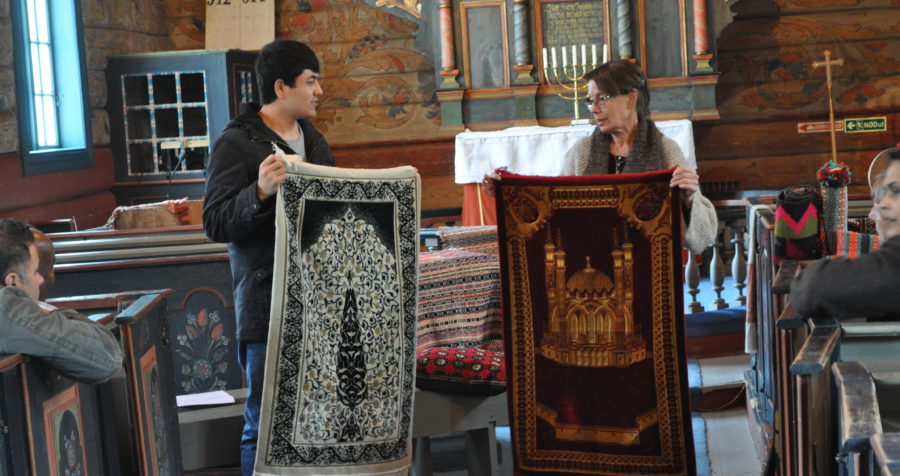Dialogue and inclusion within congregations

Background
The approach for this project was intercultural dialogue. The purpose was to investigate whether well-known art and cultural expressions in our tradition could form the basis for dialogue on the faith and philosophy of life. There were two co-operation municipalities which were chosen with refugee centres; Audnedal municipality and Åseral municipality in Vest-Agder County. The project group consisted of the bishop, a missionary counsellor and cultural adviser from the diocese, cultural consultants, refugee consultants and interpretation services in the municipalities and church staff. The project was conducted in spring 2015 with participants from Burma, China, Syria, Eritrea and Kenya as well as representatives from the Karén-people.
Caption above: The project leader Tone Svalastog Garnes and a participant. Photo: Agder og Telemark bispedømmeråd
Objectives
To demonstrate how the church’s visual arts, decor, patterns, architecture and hymnody are suitable as a starting point for dialogue in an inclusion perspective.

Inside Grindheim Church. Photo: Agder og Telemark bispedømmeråd.
How it was done
Song and music
A collection in Åseral church. This congregation’s song project confirmed the importance of first translating the hymn (by an interpreter) and giving time for conversation on Wednesdays before the hymn is to be sung on Sunday’s service. Good preparation is fundamental in order to provide an experience and a sense of achievement. The recognition of text, rhythm and melody related to the hymn in Åseral church along with the participants’ own vocal and cultural tradition gave a good basis for conversation.
Embellishment of paintings
Two collections in Grindheim church. The presentation of rosemaling with the acanthus was essential and the starting point for our meeting in this church. The acanthus is a motive in both the European and international arts and culture tradition and can be traced back to pre-Christian times. The acanthus is therefore a motive in our common cultural heritage. The presentation of the acanthus as a mutual motive led to good conversations about how flowers and plants embellish the decoration of the participants’ different church rooms and places of worship. The good flow of conversation which was established here moved on to dialogue about the various image frames on the walls and ceilings of Grindheim Church. Some of the image frames led to lively and interesting discussions about similarities and differences between the Bible and the Qur’an. Rosemaling, shape, colour and motive in Grindheim Church was a good foundation for the third collection of the prayer mat tradition in an international perspective. The timeline back to pre-Christian times and common cultural heritage was well represented and created engagement and understanding. There arose pleasant and insightful conversations about the participants’ own prayer mats.
Further Development of the project
Agder and Telemark diocese have implemented the preliminary project “Dialogue and Inclusion” in the congregations to all churches in the diocese. The main project is under development and will have reached its final form by 2018 as one of several measures in the diocese’s work for dialogue and inclusion.
Key factors
1. Recognise! Experience! Achieve!
2. Dialogue! Tolerance! Inclusion!
.
